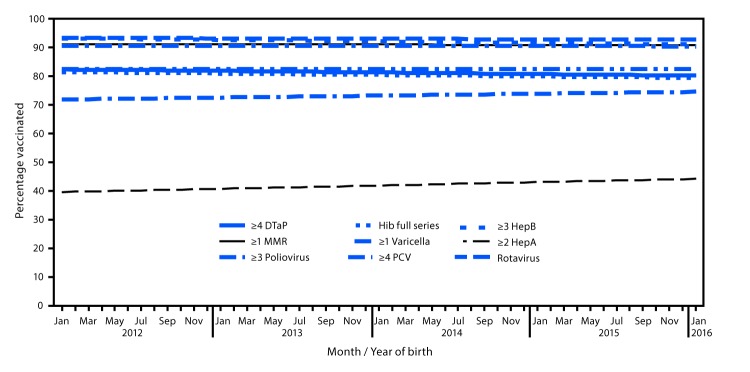FIGURE.
Estimated linear trend in coverage with selected vaccines* by age 24 months,† by month and year of birth§ — National Immunization Survey-Child, United States, 2013–2017
Abbreviations: CI = confidence interval; DTaP = diphtheria, tetanus toxoids, and acellular pertussis vaccine; HepA = hepatitis A vaccine; HepB = hepatitis B vaccine; Hib = Haemophilus influenzae type b conjugate vaccine; MMR = measles, mumps, and rubella vaccine; PCV = pneumococcal conjugate vaccine.
* Hib full series: ≥3 or ≥4 doses, depending on product type received (primary series and booster dose). Rotavirus: ≥2 or ≥3 doses, depending on product type received (≥2 doses for Rotarix [RV1] or ≥3 doses for RotaTeq [RV5]).
† Except for rotavirus, vaccination coverage was assessed before the child reached his/her 24-month birthday. The Kaplan-Meier method was used to account for censoring vaccination status for children assessed before age 24 months. Rotavirus vaccination was assessed before the child reached his/her 8-month birthday.
§ Estimated linear relationship between month and year of birth and vaccination coverage, based on weighted linear regression analysis using the inverse of the estimated variance of each point estimate to construct the weights. Estimated percentage point change over 12 birth months: ≥4 DTaP −0.55 (95% CI = -1.20 to 0.10); ≥3 poliovirus -0.17 (-0.52 to 0.18); ≥1 MMR -0.11 (-0.58 to 0.35); Hib full series -0.51 (-1.13 to 0.11); ≥3 HepB -0.53 (-0.97 to -0.09); ≥1 varicella -0.05 (-0.53 to 0.42); ≥4 PCV 0.0 (-0.69 to 0.68); ≥2 HepA 1.13 (0.30 to 1.97); rotavirus 0.68 (-0.09 to 1.45).

